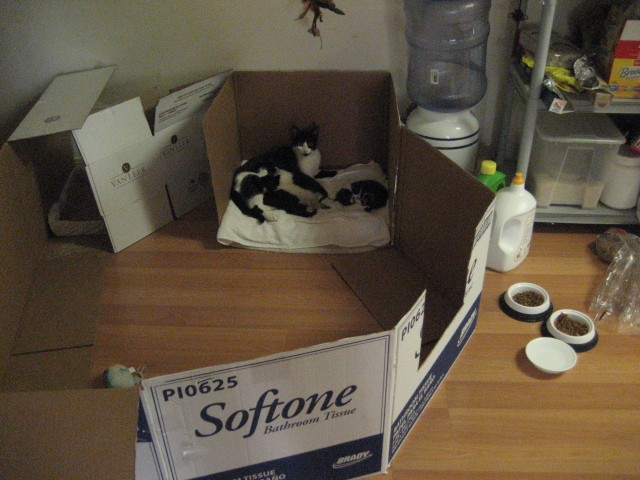QuestionI have been taking care of a stray male cat for about 7 months while he lived outside. After 6 months, once I was able to pet him, he acted like a "pet" so I knew he wasn't feral.
He's been to the vet for neutering (2 weeks ago) and vaccinations.
I had brought him into the house to be able to see the house cat through a sturdy screen. My 2 cats are terrified of him-I have 2 very timid cats.
I'm living with a friend who has 2 indoor cats also. One of his cats quickly darted through the screen barrier and the stray cat was on him in a second just as if he cat were PREY. He bit him in the neck and wouldn't let go. Housecat went to vet and all is well.
I'm looking to move into my own apartment with my 2 timid and soft housecats (a 3 year old neutered male and a 5 year old spayed female.) I am supposed to take the stray with me (he is absolutely wonderful by himself). Is there any hope to having him NOT EVER attack my 2 cats? I was so terrified at how he attacked my friend's cat. The vet says he is about 2 years old.
Do you think he could ever be safe around my other cats? If yes, how would I go about introducing them?
AnswerHi Kathy,
Yes, I think there's hope. Having just been neutered two weeks ago, he's still got quite a bit of tom cat in him. The testosterone levels have started to drop off, but they are going to continue to subside further, as should his aggressive attitude. Also, moving the cats all to a new location will level the playing field, so to speak. None of the cats will have established their territory, and they won't feel such a right to defend it. The position for dominant cat will be up for grabs. Introducing the cats slowly and carefully will still be extremely important, but it will be an opportunity for you to be a bit free of his territorial tendencies.
In my 15 years of hospice and fostering, I've had to introduce almost 250 cats at different times. Some have been more of a challenge than others, but all of them have been able to integrate into the household. There is the smallest percentage of cats that won't ever accept others, but I think if you work slowly, you will probably find this guy's biggest problem was his hormones. Try to give him another couple of weeks before beginning the introduction again.
The use of a screen door is usually ideal. Any way for the cats to see each other but not reach each other is a good way for them to get used to one another's presence without the threat of a physical confrontation. Use this method of exposure until the cats are comfortable - they will approach each other one either side of the door without growling or hair raising. It's a good idea to feed them special meals on opposite sides of the door so that they come to associate this positive experience with each other. If you don't have a screen or glass door at the new place, consider using a dog crate, covered with a sheet on all sides but one (this provides a feeling of security for the cat in the crate).
Also, scent transference will be important. Cats rely on physical appearance for identification, but also on scent. Rub the stray along the cheeks with a cloth, and then present it to the house cats for them to smell. Then rub each house cat's cheeks with a separate cloth and allow the stray to smell them. This way, the cats can become familiar with each other, again without a confrontation. Use scent transference a few times a day each day until it's time to introduce them directly. This may be a couple of weeks or longer.
The cats should be kept completely separated until there is no growling or hissing when they see each other through a barrier or when they smell each other's scents. Try switching their living space a few times a day, as well, so they can become familiar this way.
When everyone seems calm and well settled in, try a face-to-face introduction by leaving the door between their spaces open, and immediately supervise. Allow them to approach each other at their own pace. Do not allow visits to go longer than 15 minutes at first, and end the visit immediately if it goes poorly. Try again in a day or two. If it goes well, still end the visit in 15 minutes, as it can still become overwhelming. Reward everyone with treats, and have another visit a few hours later. Increase the length of the visits the next day.
Best of luck!
Jessica

 Additional info about the possbile norwegian
Question
Edmund at 4 months
I forgot to mention. Edmund
Additional info about the possbile norwegian
Question
Edmund at 4 months
I forgot to mention. Edmund
 What kind of cat do i have?
Question
Chula
Ive been trying to figure out wha
What kind of cat do i have?
Question
Chula
Ive been trying to figure out wha
 Cat meaowing after spayed
QuestionQUESTION: Hello, I am having a problem with my
Cat meaowing after spayed
QuestionQUESTION: Hello, I am having a problem with my
 mother cat needs?
Questionplay area
QUESTION: hi Jessica, my mothe
mother cat needs?
Questionplay area
QUESTION: hi Jessica, my mothe
 is my kitten a blue point?
QuestionPolar bear
QUESTION: hi, our black and w
is my kitten a blue point?
QuestionPolar bear
QUESTION: hi, our black and w